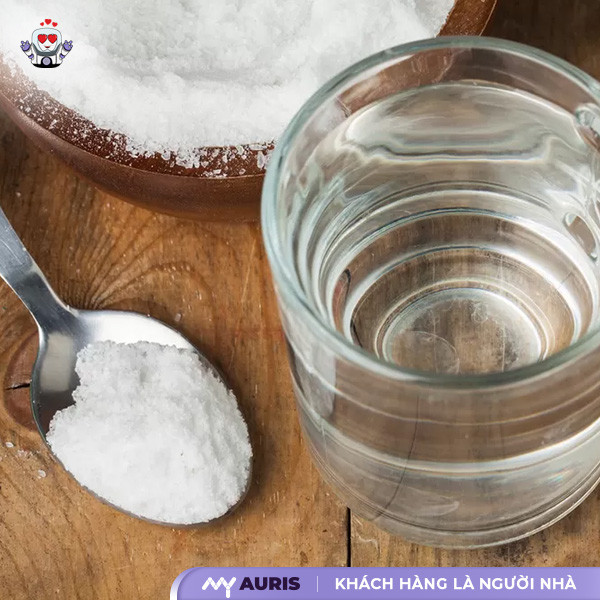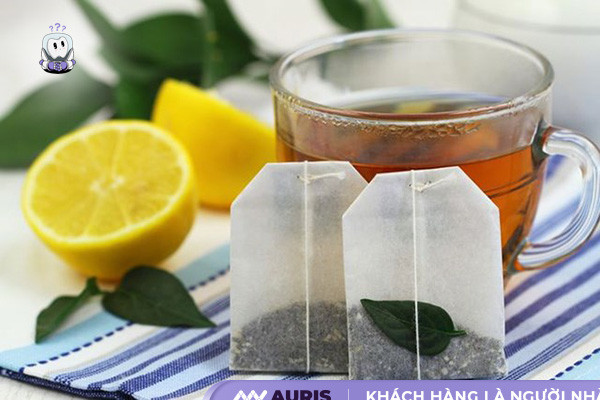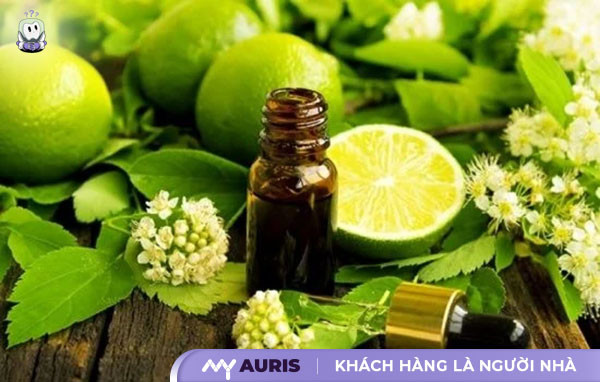Toothaches cause discomfort, affecting eating and daily life. Finding quick ways to relieve tooth pain is an urgent need. This article from My Auris Dental Clinic guides you on simple yet effective home remedies for toothache. These methods use natural, easy-to-find ingredients. However, these are only temporary solutions. If tooth pain persists, a dental visit is necessary for thorough examination and treatment.
Effective Home Remedies for Quick Toothache Relief
Cavity toothaches cause discomfort, affecting daily life. This article guides you on how to quickly relieve toothache at home using salt water and hydrogen peroxide.

Rinsing with Salt Water
Saltwater acts as an antiseptic, reducing inflammation and effectively relieving toothache. It’s simple and safe to perform.
How to do it:
Dissolve ½ teaspoon of salt in 250ml of warm water.
Rinse your mouth for 30 seconds, focusing on the painful tooth area.
Spit out the saltwater and repeat several times a day.
Rinsing with Diluted Hydrogen Peroxide
Hydrogen peroxide eliminates bacteria, reduces inflammation, and alleviates pain. Dilute it properly before use.
How to do it:
Dilute 3% hydrogen peroxide with an equal amount of water (1:1 ratio).
Rinse your mouth with the solution for 30 seconds, focusing on the painful tooth area.
Spit out the solution, do not swallow. Repeat several times daily.

Quick Toothache Relief with Cold Compress
Sudden toothache causing discomfort, affecting your work and life? A cold compress is an instant pain relief solution, easy to do at home. This method is especially helpful when the pain is due to inflammation or swelling.
How to do it:
Preparation: Ice cubes, a clean cloth.
Wrap ice: Place a few ice cubes in a clean cloth, fold it.
Apply to cheek: Place the ice pack on the outside of your cheek, over the painful tooth.
Duration: Apply for about 15-20 minutes, take a 10-minute break, then repeat.

Peppermint Tea Bags – A Relaxing Toothache Relief Therapy
Besides cold compresses, peppermint tea bags are also a natural option to help relieve toothache and gum swelling. Peppermint contains menthol, an ingredient with antibacterial and pain-relieving properties.
How to do it:
Steep tea bag: Steep a peppermint tea bag in hot water for about 1 minute.
Let it cool: Gently squeeze out excess hot water.
Apply to tooth: Place the tea bag on the painful tooth.
Hold in place: Hold for about 20 minutes. You can also hold a cooled tea bag in your mouth.
Causes of toothache: Cavities, gum inflammation, pulpitis, dental abscess, misaligned teeth, impacted wisdom teeth, external trauma…
Preventing toothache:
Proper oral hygiene: Brush teeth at least twice a day, use dental floss.
Regular dental check-ups every 6 months.
Healthy diet: Limit sweets and hard foods.
Using Garlic to Treat Toothache
Toothaches cause discomfort, affecting eating and daily life. Garlic, a common kitchen ingredient, contains allicin, a natural antibacterial and pain-relieving compound. Using garlic to treat toothache is a folk remedy widely adopted by many.
How to do it:
Preparation: 1 fresh garlic clove, peeled, crushed or thinly sliced.
Apply directly: Place the garlic on the painful tooth area. Hold for about 10-15 minutes.
Rinse: Rinse your mouth with clean water after application.
Repeat: Do this 2-3 times a day.
Garlic, an easy-to-find ingredient, helps relieve toothache at home. Combine with proper oral hygiene and a healthy diet for effective toothache prevention.
Vanilla Extract Helps Treat Toothache
Toothache, a sharp, throbbing pain, disrupts daily life. Vanilla extract, a common flavoring, contains alcohol and eugenol, which provide pain relief and antibacterial properties.
How to do it:
Preparation: Cotton swab, pure vanilla extract.
Soak vanilla: Drip a few drops of vanilla extract onto a cotton swab.
Apply to tooth: Place the cotton swab on the painful tooth area. Hold for about 5-10 minutes.
Repeat: Do this 2-3 times a day.

Cloves for Toothache Relief
Are you suffering from sudden, nagging tooth pain? Cloves, a common spice, can be an immediate pain relief solution. Folk remedies have long used cloves to treat toothache thanks to their natural antibacterial and pain-relieving properties.
How to do it:
Preparation: A few dried clove buds, a cotton swab or small gauze pad.
Crush: Grind the clove buds into a fine powder. You can use a mortar and pestle or a spoon.
Apply directly: Use a cotton swab or gauze pad to apply the clove powder directly to the painful tooth. Hold for about 15-20 minutes.
Rinse: After the time is up, rinse your mouth with warm water.
Cloves do not replace professional dental treatment. Regular dental check-ups help prevent and effectively treat dental conditions.

Guava Leaves for Toothache Relief
Young guava leaves contain numerous antibacterial and anti-inflammatory compounds, useful in reducing toothache and gum inflammation. This folk remedy is easy to perform, safe, and economical.
How to do it:
Preparation: A handful of young guava leaves, clean water.
Wash thoroughly: Rinse the guava leaves thoroughly under running water to remove dirt.
Boil: Place the guava leaves in a pot, add enough water to cover them. Boil for about 15 minutes.
Rinse: Let the water cool down, then use it as a mouthwash. Swish for about 5-10 minutes each time, repeating 2-3 times a day.
Alternative method:
Chew directly: Chewing young guava leaves directly can also help relieve pain. Chew the young leaves thoroughly, then hold the pulp on the painful tooth area for about 15-20 minutes.
Rinse: Afterward, rinse your mouth with warm water.
Persistent or recurrent toothache requires examination by a dentist. Self-treatment at home should only be applied for mild pain and for a short duration. Schedule an appointment with your dentist to protect your long-term oral health.

Wheatgrass for Effective Toothache Relief
Are you suffering from nagging tooth pain? Wheatgrass might help you. It contains many anti-inflammatory, antibacterial, and pain-relieving properties. Here’s how to use it:
Ingredients:
Fresh wheatgrass.
Juicer (or mortar and pestle).
Strainer.
Instructions:
Wash the wheatgrass thoroughly.
Juice it (or crush and then strain).
Rinse your mouth with wheatgrass juice for 30 seconds.
Spit it out, repeat 2-3 times daily.
Thyme to Soothe Toothache
Thyme is easy to find and use. Its antibacterial and pain-relieving properties effectively reduce toothache.
Ingredients:
- Fresh thyme leaves.
Method 1: Chew directly:
Wash the thyme leaves thoroughly.
Chew the thyme leaves thoroughly at the location of the painful tooth.
Hold for about 10-15 minutes, then spit out the pulp.
Method 2: Rinse:
Wash the thyme leaves thoroughly.
Boil the thyme leaves with water.
Let it cool, then use as a mouthwash.

Aloe Vera for Home Toothache Treatment
Aloe vera is renowned for its antibacterial and wound-healing properties. It can help reduce toothache and gum inflammation.
Ingredients:
- Fresh aloe vera leaf.
Instructions:
Wash the aloe vera leaf thoroughly.
Extract the gel from inside.
Apply the aloe vera gel to the painful gum area.
Massage gently.
Leave for about 20 minutes, then rinse your mouth with clean water.

Toothache Pain Relievers
Toothaches cause discomfort, affecting daily life. Over-the-counter pain relievers can quickly alleviate the pain.
How to use:
Choose medication: Paracetamol and Ibuprofen are common and relatively safe. Read the instructions carefully before use.
Dosage: Adhere to the recommended dosage. Do not arbitrarily increase the dose.
Duration: Use for a short period. If pain persists, consult a dentist.

Home Remedy for Cavity Toothache Using Fresh Ginger Water
Ginger has anti-inflammatory and pain-relieving properties. Ginger water helps reduce swelling and sensitivity caused by toothache.
How to use:
Preparation: Wash fresh ginger thoroughly, then crush it.
Make the water: Steep the crushed ginger in boiling water for about 10 minutes.
Rinse: Swish the ginger water in your mouth for a few minutes, then spit it out. Repeat several times throughout the day.

Using Lemon Leaf Essential Oil
Lemon leaf essential oil is antibacterial and pain-relieving. It helps reduce inflammation and swelling caused by toothache.
How to use:
Preparation: Drip a few drops of lemon leaf essential oil onto a cotton swab.
Apply directly: Dab the cotton swab onto the painful tooth area.
Repeat: Do this several times daily.

Elevating Your Pillow While Sleeping
Lying with your head low causes blood to rush to the head, increasing pressure on the painful tooth area. Elevating your pillow helps reduce pressure and pain.
How to do it:
Choose a pillow: Use a pillow high enough to support your head and neck.
Sleeping position: Sleep on your back, avoid sleeping on your stomach or on the side of the painful tooth.
Causes of Toothache
Toothaches cause discomfort, affecting daily life. Understanding the causes helps in effective prevention and treatment. Common causes of toothache include:
- Tooth decay
Tooth decay is the leading cause. Bacteria attack tooth enamel, creating cavities. As cavities progress, they cause aching and sensitivity when consuming hot, cold, or sweet foods. If left untreated, tooth decay can spread to the tooth pulp, causing severe pain.
- Gingivitis
Inflamed gums are red, swollen, and bleed easily when brushing. Severe gingivitis can lead to gum recession, exposing tooth roots, which causes pain. Poor oral hygiene and smoking are risk factors for gingivitis.
- Dental abscess
Infection at the root of the tooth forms pus, leading to an abscess. An abscess causes severe pain, facial swelling, and fever. Immediate treatment is necessary to prevent dangerous complications.
- Cracked or fractured tooth
Teeth can crack or fracture due to trauma or biting on hard foods. Cracks allow bacteria to penetrate, causing pain. Severe cracked or fractured teeth require dental treatment.
- Extremely hot or cold foods
Consuming excessively hot or cold foods causes tooth sensitivity, especially when teeth are already sensitive. This sensitivity usually disappears quickly.
- Pulpitis
Pulpitis causes severe, persistent pain that can radiate to the ear and jaw. Pulpitis is often due to untreated tooth decay.
- Temporomandibular joint (TMJ) disorders
TMJ disorders cause pain in the jaw, ear, and difficulty chewing or opening the mouth. Stress and teeth grinding are common causes.
Notes When Treating Toothache at Home
Self-treating toothache at home can provide temporary relief. However, consider the following to avoid harming your oral health:
Do’s
Follow instructions carefully when using natural remedies. For example, when rinsing with salt water, mix the correct ratio and rinse gently. When using peppermint tea bags, ensure the tea has cooled down to avoid burns. Apply a cold compress to the outside of the cheek for 20 minutes at a time to reduce swelling and pain.
Choose natural ingredients and ensure they are clean. Garlic, guava leaves, and essential oils should be thoroughly washed before use.
If tooth pain persists or shows signs of infection like swelling or fever, see a dentist immediately. Self-treatment at home is only a temporary solution and does not replace professional care.
Combine natural remedies with good oral hygiene. Brush your teeth at least twice a day, use dental floss, and mouthwash to remove plaque and bacteria.
Don’ts
Absolutely do not use antibiotics without a doctor’s prescription. Misusing antibiotics can lead to dangerous side effects and antibiotic resistance.
Avoid excessively hot, cold, sweet, or hard foods when you have a toothache. These foods can aggravate the pain. Limit carbonated drinks, alcohol, and tobacco.
Do not apply unverified or dangerous folk remedies. Some tips can cause damage to gums, soft tissues, or tooth enamel.
Do not attempt to extract teeth or treat complex dental problems at home. Consult a dentist for proper examination and treatment.
Do not neglect regular dental check-ups. Regular dental exams help detect oral problems early and allow for timely treatment, preventing toothache.
Methods for Preventing Toothache from Early On
Diet directly affects oral health. Limiting sweets, carbonated drinks, and acidic foods helps prevent tooth decay, the main cause of toothache.
Reduce consumption of sweets, candies, and carbonated soft drinks. Eat plenty of fruits and vegetables, rich in fiber, vitamins, and minerals. Drink enough water to help clean the oral cavity and remove bacteria.
Proper oral hygiene removes plaque and bacteria, preventing tooth decay and gingivitis. Brush your teeth at least twice a day, in the morning after waking up and at night before bed. Use a soft-bristled toothbrush and fluoride toothpaste. Brush gently, using circular motions, for about 2 minutes. Use dental floss daily to clean between teeth. Rinse your mouth with a specialized mouthwash or diluted salt water.
Regular dental check-ups help detect oral problems early, provide timely treatment, and prevent complications. Have dental check-ups every 6 months. Follow your dentist’s instructions for care and treatment.

How to Permanently Relieve Toothache at the Dental Clinic
A dentist examines and diagnoses the cause of toothache. They check teeth, gums, and take X-rays if necessary. This accurately identifies the problem, leading to a suitable treatment plan. This process helps understand the oral condition and rule out serious pathologies.
Depending on the cause, the dentist will provide suitable treatment methods such as:
Dental fillings: For small cavities, the dentist will fill the tooth. Filling material seals the cavity, preventing bacterial entry.
Root canal treatment: For severe cavities where bacteria have penetrated the tooth pulp, causing inflammation. Root canal treatment removes the infected pulp, cleans the root canals, and seals them.
Tooth extraction: If a tooth is severely damaged and cannot be restored, the dentist will extract it. This is a last resort, helping to eliminate the source of pain.
Surgery: For dental abscesses or cysts, the dentist performs surgery to remove them. Surgery helps eliminate infected tissue and prevents spread.
Porcelain crowns: For teeth that are fractured or extensively chipped, the dentist applies porcelain crowns to protect them and restore chewing function.





